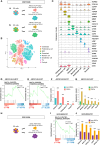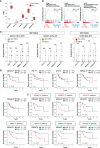Role of proteoglycan synthesis genes in osteosarcoma stem cells
- PMID: 38690160
- PMCID: PMC11058990
- DOI: 10.3389/fonc.2024.1325794
Role of proteoglycan synthesis genes in osteosarcoma stem cells
Abstract
Osteosarcoma stem cells (OSCs) contribute to the pathogenesis of osteosarcoma (OS), which is the most common malignant primary bone tumor. The significance and underlying mechanisms of action of proteoglycans (PGs) and glycosaminoglycans (GAGs) in OSC phenotypes and OS malignancy are largely unknown. This study aimed to investigate the role of PG/GAG biosynthesis and the corresponding candidate genes in OSCs and poor clinical outcomes in OS using scRNA-seq and bulk RNA-seq datasets of clinical OS specimens, accompanied by biological validation by in vitro genetic and pharmacological analyses. The expression of β-1,3-glucuronyltransferase 3 (B3GAT3), one of the genes responsible for the biosynthesis of the common core tetrasaccharide linker region of PGs, was significantly upregulated in both OSC populations and OS tissues and was associated with poor survival in patients with OS with high stem cell properties. Moreover, the genetic inactivation of B3GAT3 by RNA interference and pharmacological inhibition of PG biosynthesis abrogated the self-renewal potential of OSCs. Collectively, these findings suggest a pivotal role for B3GAT3 and PG/GAG biosynthesis in the regulation of OSC phenotypes and OS malignancy, thereby providing a potential target for OSC-directed therapy.
Keywords: 3glucuronyltransferase 3; glycosaminoglycan; osteosarcoma; osteosarcoma stem cell; proteoglycan; β-1.
Copyright © 2024 Osumi, Sugihara, Yoshimoto, Tokumura, Tanaka and Hinoi.
Conflict of interest statement
EH received grants from the Japan Society for the Promotion of Science for this study. The remaining authors declare that the research was conducted in the absence of any commercial or financial relationships that could be constructed as a potential conflict of interest.
Figures



Similar articles
-
RARRES2 is involved in the "lock-and-key" interactions between osteosarcoma stem cells and tumor-associated macrophages.Sci Rep. 2024 Jan 27;14(1):2267. doi: 10.1038/s41598-024-52738-5. Sci Rep. 2024. PMID: 38280909 Free PMC article.
-
The Role of Tumor Microenvironment in Regulating the Plasticity of Osteosarcoma Cells.Int J Mol Sci. 2022 Dec 18;23(24):16155. doi: 10.3390/ijms232416155. Int J Mol Sci. 2022. PMID: 36555795 Free PMC article. Review.
-
Functional validation of novel compound heterozygous variants in B3GAT3 resulting in severe osteopenia and fractures: expanding the disease phenotype.BMC Med Genet. 2016 Nov 21;17(1):86. doi: 10.1186/s12881-016-0344-9. BMC Med Genet. 2016. PMID: 27871226 Free PMC article.
-
Analysis of microRNA expression in CD133 positive cancer stem‑like cells of human osteosarcoma cell line MG-63.PeerJ. 2021 Sep 3;9:e12115. doi: 10.7717/peerj.12115. eCollection 2021. PeerJ. 2021. PMID: 34557357 Free PMC article.
-
The clinical and mutational spectrum of B3GAT3 linkeropathy: two case reports and literature review.Orphanet J Rare Dis. 2019 Jun 13;14(1):138. doi: 10.1186/s13023-019-1110-9. Orphanet J Rare Dis. 2019. PMID: 31196143 Free PMC article. Review.
Cited by
-
In silico-based analysis and in vitro experiments identify SIGMAR1 as a potential marker of putative lung cancer stem cells.Discov Oncol. 2025 Apr 26;16(1):620. doi: 10.1007/s12672-025-02394-6. Discov Oncol. 2025. PMID: 40285994 Free PMC article.
-
A Novel Prognostic Signature Integrating Immune and Glycolytic Pathways for Enhanced Prognosis and Immunotherapy Prediction in Hepatocellular Carcinoma.J Hepatocell Carcinoma. 2025 Apr 18;12:805-823. doi: 10.2147/JHC.S510460. eCollection 2025. J Hepatocell Carcinoma. 2025. PMID: 40264860 Free PMC article.
-
PDK1-dependent metabolic reprogramming regulates stemness and tumorigenicity of osteosarcoma stem cells through ATF3.Cell Death Dis. 2025 Jul 29;16(1):574. doi: 10.1038/s41419-025-07903-7. Cell Death Dis. 2025. PMID: 40730548 Free PMC article.
-
The Identification of a Glucuronyltransferase-Related Gene, GlcAT-S, with Putative Mucus Protection and Anti-Inflammatory Effects from Gut-Damaged Drosophila by Dextran Sulfate Sodium (DSS).Biology (Basel). 2025 May 7;14(5):513. doi: 10.3390/biology14050513. Biology (Basel). 2025. PMID: 40427702 Free PMC article.
References
LinkOut - more resources
Full Text Sources
Research Materials

